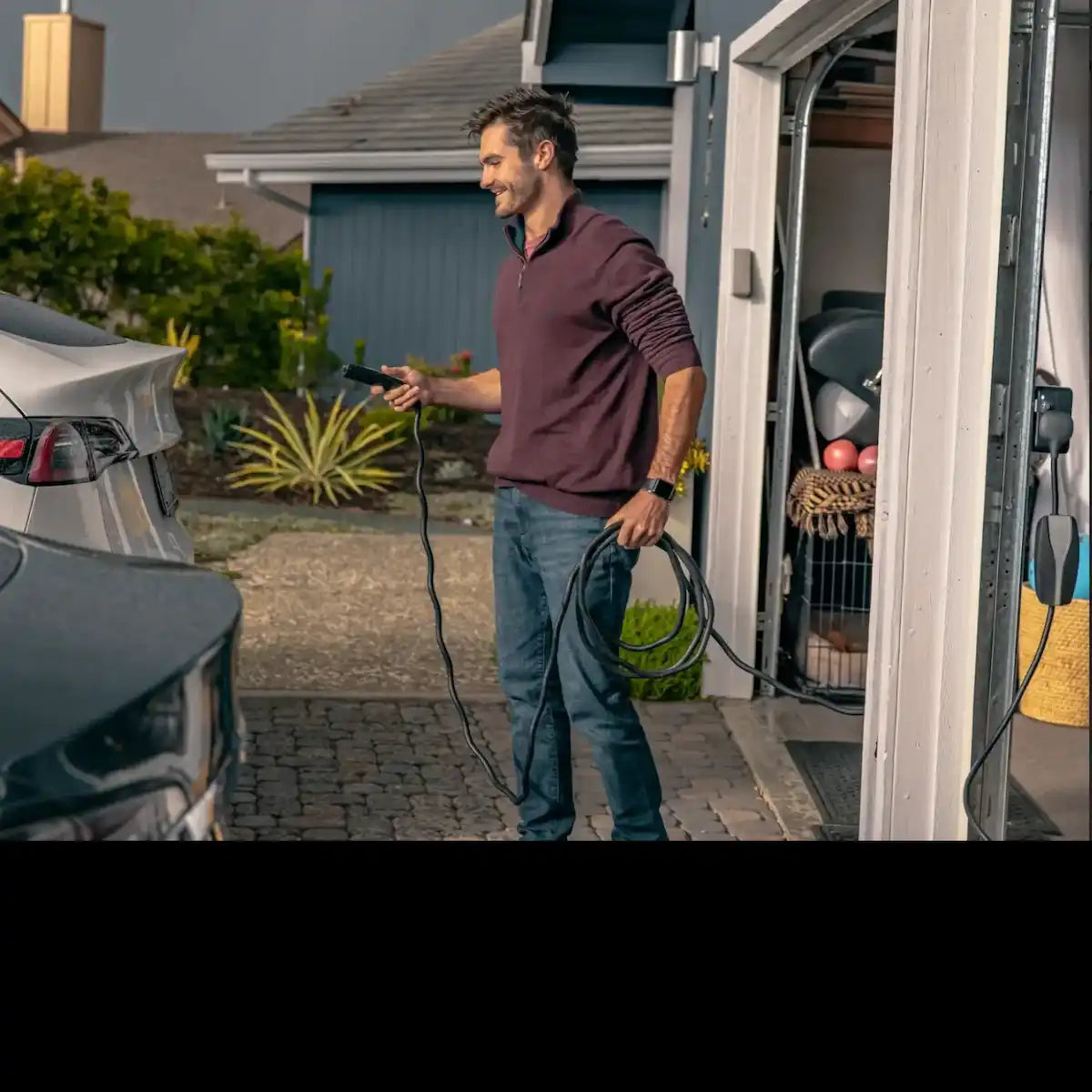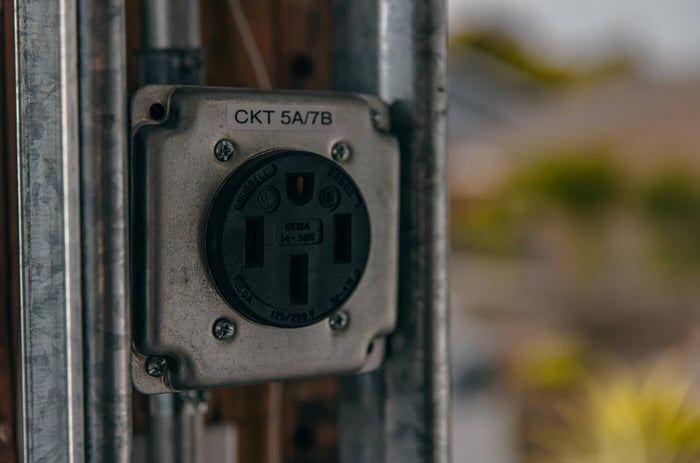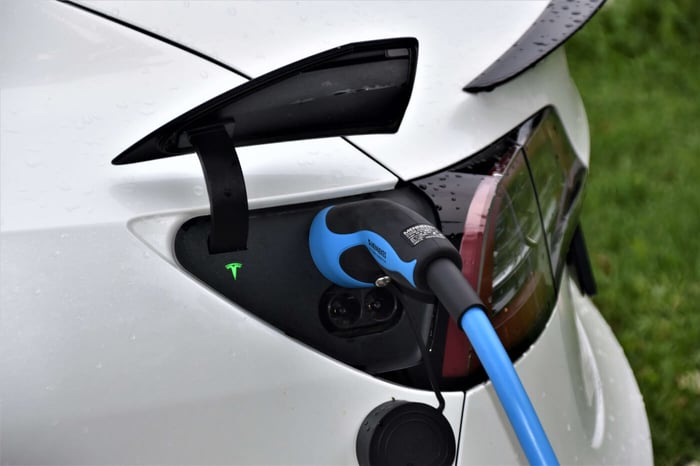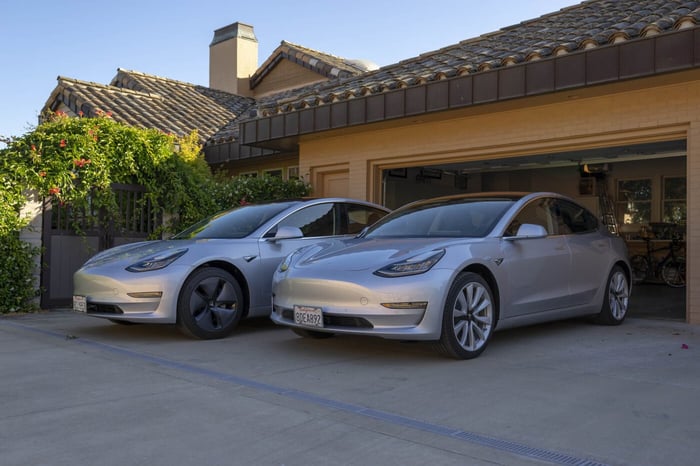Updated: August 1, 2025
Key Takeaways:
- Level 1 (120V): NEMA 5-15 standard household outlet - 4 miles/hour charging
- Level 2 (240V) - Best Options: NEMA 14-50 (40A charging), NEMA 14-30 (24A), NEMA 10-30 (24A) NEMA 6-50 (40A) - 21-35 miles/hour
- Most Popular: NEMA 14-50 outlet provides fastest home charging (30+ miles/hour)
- Existing Outlet: Use Smart Splitter to share dryer/range outlet with EV charger
- Installation Cost: New 240V outlet $700-2,000 vs. Smart Splitter $349
The NeoCharge App is now available - sync your EV and utility rate to ensure your car charges at the cheapest times to save $300+/year. Completely free - Try it today!
Charging an electric vehicle (EV) can seem a bit complicated at first. However, after some experience it will become very habitual. One topic that can trip a lot of prospective or first-time EV drivers are the proper electrical outlets for EV chargers.
There are in fact many different electrical outlets for EV chargers. Some are low power for Level 1 charging, while others are higher power for Level 2 charging.
Selecting the right Electric Vehicle Supply Equipment (EVSE or “charger”) or directing an electrician to install the correct outlet takes the proper education. If the wrong charger is purchased or the wrong outlet is installed, you may find yourself unable to charge. An additional consideration is how many EVs you are planning to charge - both in the short term and long term if multiple members of your household plan to go electric.
If you need assistance or have questions on what outlet is right for you, feel free to reach out to the NeoCharge customer support team who are experts in home EV charging applications. You can also find all our frequently asked questions here.
Let’s go over all the different types of electrical outlets for EV chargers so you are best prepared to set up your home EV charger. Note that the electrical content of this article is pertinent only to the U.S. and Canada.
Summary:
- Types of 120 Volt Outlets
- Types of 240 Volt Outlets
- Best Electrical Outlets for Electric Car Chargers
- Electrical Outlets Not Suited Well for Electric Car Chargers
- Final Thoughts
Types of 120 Volt Outlets
A good way of thinking about electrical outlets is to group them in their voltage classification. There are two voltages for residential applications, 120 Volts (V) and 240V. In general, the fewer the volts, the less power.
Let’s begin with the low-power group, the 120V. A 120V receptacle is the typical household outlet. You use these for nearly all of your devices (TV, phone charger, blender, etc.).
There are a few 120V outlets, however, by far the most common is the NEMA 5-15. NEMA is the acronym for National Electric Manufacturers Association. The first set of digits is the outlet class (5) and the second set is the maximum current (15 amps).
The typical household outlet, the NEMA 5-15, is the shocked-face thing you have seen for your entire life. It has been by your side (literally) when you need it most.
There are a few other 120V outlets, however, they are much, much less common in residential construction.
See, it’s simple!
Types of 240 Volt Outlet
Next up is 240V outlets. Unfortunately, there are many different types of 240V outlets. For those of you with an electric dryer, range, welder, etc., you may have seen these before, however, for others, these outlets could look quite foreign.
The most popular 240V outlets are now the NEMA 14-30, 14-50, and 6-50. Like voltage, the more amps, the more power.



A general rule of thumb to distinguish a 120V outlet from a 240V outlet is by the size of the outlet. In most cases, a 240V outlet is larger.
It is also worth noting that gas appliances utilize 120V power, therefore, are not capable of converting to 240V.
Best Electrical Outlets for Electric Car Chargers
Level 1
So now that you know the common receptacles, what are the best types of electrical outlets for EV chargers?
For Level 1 chargers, the NEMA 6-15 outlet is the best outlet. Well, it's really your only option for 120V. Nevertheless, With a Level 1 charger, you can expect to charge an electric car at a rate of 4 miles of range per hour.
%20(1).jpg)
Keep in mind that a Level 1 charger comes standard with every EV. So getting started with Level 1 charging is fairly easy as you plug the charger into any available household outlet and begin to charge, albeit at a slow pace.
To put this into perspective, to charge a Tesla Model 3 from empty to full on a Level 1 charger, it will take about 35 hours. For faster charging, look to Level 2 charging with a 240V outlet.
Level 2
The best 240V (Level 2) electrical outlets for electric car chargers are the NEMA 14-30, 14-50, 10-30, 10-50, and 6-50. Depending on the amperage, a Level 2 charger can provide around 20-30 miles of range per hour. 30A circuits (e.g. NEMA 14-30 outlet) provide about 20 miles of range per hour while 50A circuits (e.g. NEMA 14-50 outlet) provides around 30 miles per hour.
Great electrical outlets for electric car chargers!
Remember--the numbering is simple, the first set of digits is the outlet class and the second set is the maximum current (amps) that can be drawn.
Now that is a lot quicker than Level 1. Overnight, a Level 2 charger can easily recharge any electric car to 100%. This is why many EV drivers choose to install a Level 2 charger over a Level 1. With Level 1 charging, an all-electric car may not fully recharge overnight, however, with Level 2 it definitely will.
Unlike the standard Level 1 charger, a Level 2 charger needs to be separately purchased. Additionally, most garages may not have a spare 240V outlet. Therefore, you will need to hire an electrician to install a new outlet and possibly upgrade your electrical panel. All of this can cost hundreds of dollars to thousands of dollars if a panel upgrade is needed. No bueno!
Fortunately, for those who have an existing 240V outlet currently occupied by an appliance or EV charger, there is a smarter and more affordable solution than to install a new circuit! The 240v Smart Splitter by NeoCharge plugs into an existing 240V outlet to create two outlets from one.
The Smart Splitter intelligently and automatically directs the power to the device in need. In other words, the Smart Splitter is like a smart power strip for high power devices. Furthermore, the Smart Splitter is compatible with all EV models, EV chargers, electric appliances, and any 240V outlet. Learn more about the Smart Splitter.
Electrical Outlets Not Suited Well for Electric Car Chargers
As aforementioned, there are not many other 120V outlets, therefore, it is hard to go wrong when needing to find an outlet for Level 1 charging. 240V, on the other hand, is a bit more complicated.
The NEMA 1-15 and 6-15 are not great electrical outlets for electric car chargers. The 1-15 outlet in particular is the old style without any ground conductor. Modern electrical wiring includes a ground wire for safety. In fact, the EV charger itself requires a ground, therefore, will not work with an outlet that does not have a ground conductor.
The NEMA 6-15 outlet is another outlet that isn’t a great choice for an EV charger. This outlet is typically used for window-mounted air conditioning units, but does not provide a lot of amperage (current), meaning it won’t charge the car as quickly as a higher current outlet like the 50A NEMA 14-50.
If for some reason you have any of these non-standard EV outlets, there are two options:
First option is to have your electrician replace the outlet with an EV charger-friendly receptacle. Of course, the breaker and the wire limit the maximum current, therefore, you will need to select an appropriate outlet that matches the corresponding circuit amperage.
Second option is to utilize the NeoCharge Smart Splitter. As aforementioned, the Smart Splitter can be customized to match the existing outlet in your home and provide you two outlets for charging. In many cases, this will be by far the most cost effective option.
It is highly recommended to consult with an electrician before conducting any work. Of course, with the Smart Splitter, no electrician is required since you simply plug in the device to the existing outlet.
Final Thoughts
Congratulations! If you’ve made it this far, you’ve learned a lot about what are the best and not so great electrical outlets for electric car chargers.
No matter if you use Level 1 or Level 2 charging, having a consistent and reliable place to charge an EV will make ownership much easier.
And for the individuals that do not have access to charging, there are literally thousands of public charging stations, you just may not have noticed them. Per the Law of Attraction, once you start looking for them you will begin to see them everywhere! For example, check out the EVmatch network below. EVmatch is just one of many EV public charging networks.
.png)
With a new home charging routine, you’ll quickly realize that charging an electric car is really easy! After a short time, charging your EV will become just like charging any other electrical device, such as your phone. Charging will be as simple as plugging in and waking up with the battery you deserve.
Charge on!
FAQs
Q: Do I need to upgrade my electrical panel for EV charging?
A: Usually not. If you have an existing 240V outlet (dryer/range), your panel can likely handle EV charging. Panel upgrades are only needed if adding new high-amp circuits.
Q: What's the best electrical outlet for EV charging at home?
A: The NEMA 14-50 (240V, 50-amp) outlet is the gold standard for home EV charging, providing 30-35 miles of range per hour. It's what Tesla and most manufacturers recommend.
Q: Can I use my dryer outlet to charge my EV?
A: Yes! Most dryer outlets are NEMA 14-30 (30-amp) and work perfectly for EV charging. Use a NeoCharge Smart Splitter to share the outlet between your dryer and EV charger safely.
Q: What's the difference between NEMA 14-30 and NEMA 14-50 outlets?
A: NEMA 14-50 (50-amp) charges faster than NEMA 14-30 (30-amp). The 14-50 provides ~30 miles/hour vs. ~20 miles/hour for the 14-30. The 14-30 is usually found on dryers in homes built after 1996. Both are excellent for daily charging.
Q: How long does it take to charge an EV with different outlets?
A: NEMA 5-15 (120V): 35+ hours for full charge. NEMA 14-30 (240V): 8-12 hours. NEMA 14-50 (240V): 6-8 hours for most EVs.
Q: Can I charge a Tesla with any of these outlets?
A: Yes, Tesla includes adapters for NEMA 5-15 and 14-50. You can buy additional adapters for NEMA 14-30, 6-50, and 10-30 outlets from Tesla or third-party suppliers or NeoCharge.
Q: What outlet does my electric range/oven use?
A: Most electric ranges use a NEMA 10-50 outlet which are perfect for EV charging. You can share this outlet using a NEMA 10-50 50 Amp Smart Splitter.
Q: Which outlets should I avoid for EV charging?
A: Avoid NEMA 1-15 (no ground wire) and NEMA 6-15 (only 15 amps). These older outlets don't provide enough power or safety features for modern EV charging.
Q: Can I use an extension cord with my EV charger?
A: For 240V outlets, only use heavy-duty, EVSE-rated extensions designed specifically for EV charging applications.
Q: How do I identify what outlet type I have?
A: Count the prongs and check the shape. 3-prong: likely NEMA 6-50 or 10-30 (dryers). 4-prong: NEMA 14-30 or 14-50 (higher powered for EV charging). Look for numbers printed on the outlet face.
Q: Can I charge two EVs from one outlet?
A: Yes, with the Dual EV NEMA 14-50 Smart Splitter from NeoCharge, it will manage power automatically for your EV charging at home. It can charge two EVs simultaneously or prioritize one while the other waits.












